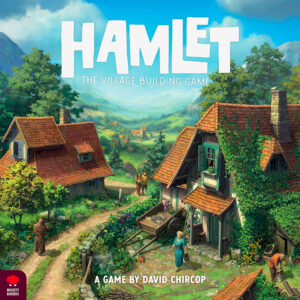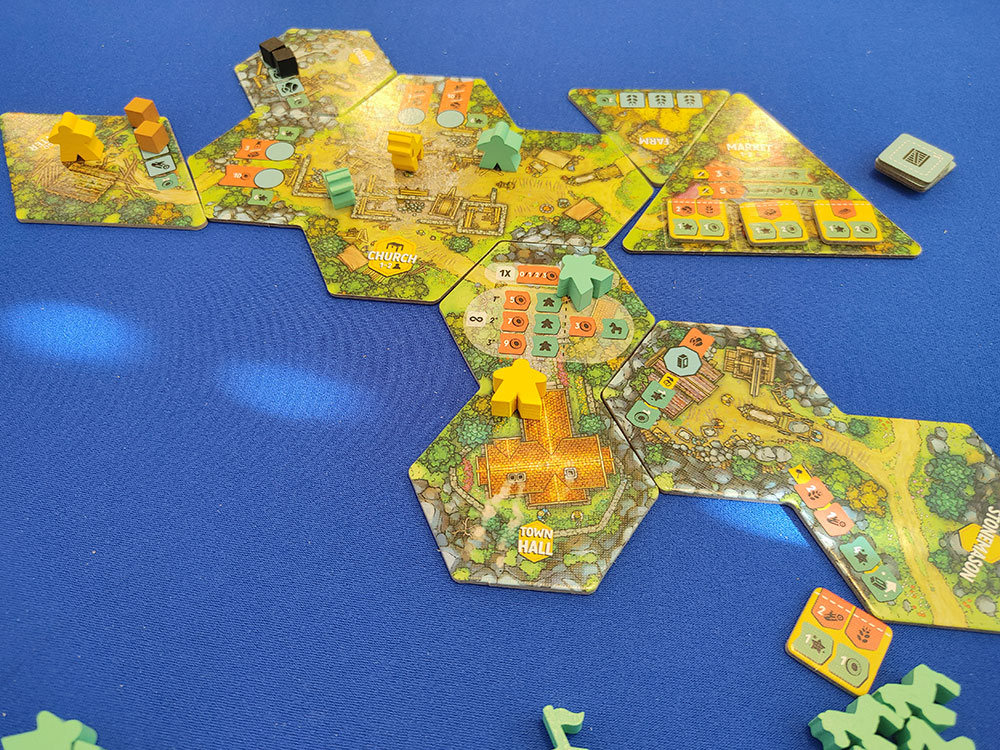 This is a review of the game Hamlet and I already know what you’re thinking, Dear Readers: “This clown is going to be making a ton of Shakespeare jokes in this review.” And you’re right.
This is a review of the game Hamlet and I already know what you’re thinking, Dear Readers: “This clown is going to be making a ton of Shakespeare jokes in this review.” And you’re right.
To be (a good game) or not to be (a good game). That is the question. The answer, I’m afraid, is not what I had hoped. But, as is the case with any trustworthy critic, to its own self this review must be true. (That one was a paraphrase of the actual quote, but it still counts.)
Hamlet: The Village Building Game is a tile-laying game for 1-4 players designed by David Chircop. The box says it takes just 25 minutes per player to play (insert hilarious sarcastic laughing gif here—more on that later).
Gameplay Overview:
In Hamlet, players are going to have access to a pile of components that they can either unlock (like extra workers) or utilize (like roads and bridges) throughout the game. Most turns will involve moving and then triggering one of their workers in the village. Workers can move as many tiles as possible around the village so long as there is a connected path for them to travel.
Once at a location, these workers can use the tile’s ability; these can be anything from acquiring or producing resources or using them to gain other items or build things around the village. There are a lot of permutations of this concept, and most of the tiles in the game offer a slight variation on this.

Players also have donkeys stationed around town. These donkeys can move, but only one tile at a time. Their main function is to create a route by which goods can be moved across tiles. Each good can travel one space for free (I guess wood can walk for a short distance?), but after that, they will need to be passed along a donkey train until they reach the location where they are needed.
Players can also use their turn to buy blueprints for new plots of land around the village. Once purchased, these blueprints can be added to the village on a later turn. Purchasing certain standard blueprints will cause newer, more complicated blueprints to be added to the blueprint draw bag.
When ultimately placing these blueprints into the village, players will need to observe some fairly convoluted adjacency rules. In the simplest terms: each tile is comprised of “sections” of a side (up to a maximum of three such sections can exist on each side). For a tile to be adjacent to another, at least one full section—not side—must completely touch another full section of an already placed tile. Things like roads and terrain types don’t have to match, but any mismatched terrain won’t be traversable until a special “pathway” is made on a later turn.

On the topic of these pathways, connected roads are always instantly walkable by players’ workers, but mountain-to-mountain and forest-to-forest connected tiles need a special path built between them. Doing so not only makes them travelable for all players but gives points to whoever builds them. Mountain-to-forest connections can never be made because, well, that’s what the rulebook says.
The resources around the village don’t belong to any single player and are shared by everyone. So filling one stonemason location actually gives other players more stuff they can use. Resources are never collected either; they are only spent the moment they are needed. Most of these resources are used rather quickly to build out new tiles or at the market, but one of the game’s main features is delivering goods to the church at the center of the village. This rewards points and acts as the game’s timer.
Once the church is completed, the game lasts one final round and then points are tallied. Unique scoring ribbons collected during the game are scored as are standard tile-laying things like the longest route leftover money and the player with the most points is the best actor at the Globe Theater. Or something.

Game Experience:
I’ll start with a mini spoiler: This is not going to be a positive review. Which is a shame because on its face, Hamlet looks like a game that has a lot going for it. The main concept of a Carcassone-style tile-laying game with irregularly shaped tiles is intriguing.
Unfortunately, all that is lost the first time players have to actually add a tile to the village. It is incredibly confusing trying to figure out which locations correctly adhere to the adjacency rules of the game. The notion that each tile has different segments and only one of those segments needs to connect to a different segment of another tile to be considered adjacent even if those two tiles have different terrain is something of a head trip to comprehend, let alone explain to new players.

This does become easier to digest as the game progresses but it’s further bogged down once you realize that connecting certain terrain requires the purchasing of bridges or paths that require certain resources. This is also difficult to remember when it comes to moving your workers around because many sections of the Hamlet will be adjacent but not connected by a pathway and therefore not accessible to meeples who are next to the tile. If you have this rulebook memorized or have played this game a ton perhaps this would become second nature, but in a game that’s already fairly tricky to internalize, it can be an issue.
Further complicating this somewhat convoluted ruleset is that the tiles themselves are difficult to read. The artwork is fine to the extent there is any but the tiles have so much information packed on them that figuring out exactly what you need to look at on any given turn is a bit of a nightmare.

In addition to the unique tile size concept, the other thing the game has that’s inventive is the use of a shared resource system. Since all players can refill and then spend the collective resources of the Hamlet there is a bit of a push and pull about when is the right time to buy certain things. This is interesting at first glance but becomes less so once it’s tied to the game’s confusing route-building mechanism where resources need to be moved along a connected string of donkeys. Forget how this is thematically confusing (so the donkeys don’t move the goods just pass them along?), It’s also difficult to comprehend in real time especially since resources can move one space for free no matter what and then they need to be moved along a donkey route.
The biggest issue I had with the game was simply its length. The box says that it will take 25 minutes per player. My first play of this game was a two-player semi-teach session and we were at the two-hour mark while the game’s main timing mechanism—the building of the church—was still only a quarter of the way complete. Further plays did speed this up slightly but this game is far too long for what it is and loses points just because of the false advertising of the stated length on the box.
Final Thoughts:
As I said at the outset of the last section I’m disappointed that Hamlet fell as flat as it did for me. I like a few of the concepts like the oddly shaped tiles and the shared resource system but neither works in any real way during the game itself. Turns go by very quickly but not in the good way that a Euro game strives for. Rather it seems like players just do things on a turn to set up a turn six turns away. “I’ll get this donkey now so that I might be able to use him in an hour to move that one piece of wood three spaces instead of two.” It’s an odd grind of a design that feels incohesive and more like a collection of disjointed parts rather than a singular whole. Even the ribbons that players acquire throughout the game that multiply their scoring opportunities seem fairly random and hard to actually strive for.
Final Score: 2 Stars – A few good ideas bogged down by messy game flow and iffy components. And the rest is silence.
 Hits:
Hits:
• Resource and oddly sized tile concepts are fine
Misses:
• Busy graphic design
• Way too long
• Convoluted resource rules
• Most turns—although quick—don’t feel like they involve enough meaningful (or fun) decisions
• Sub-par iconography






















Interesting. None of the problems you mention with the game design or gameplay seemed to worry me.
We had no trouble with locations adjacency. Trees-trees- rocks-rocks. We were only puzzled with the building action where you can build location without any connection by the road (which you create subsequently). On the other hand, I was impressed how one can forge lovely terrain from such inconvenient tiles.
There is so little text in the game – few badges which are logically tied to few conditions in the and each tiles is generally point maker depending on adjacency, roads and legth. It is true that during the first play you are unable to comprehend everything but second game for me will not reveal anything new.
I could disagree that turn actions are not meaningful or joyful. Thanks to the variety of actions everybody can focus on different actions which I found really nice and sandbox-y comparing it to the different games where all resources, points, actions are so tight.
Our semi-learn two-player competitive game took roughly 1,5 hrs and it was fun. Actually I think you did something wrong – if somebody focuses on the church completion the game could be much shorter (for us).
All in all I think this game is suited for family evenings or non-competitive gamers. However, I believe, there is still that competitive part hidden under the second layer. 🙂 (3/5)